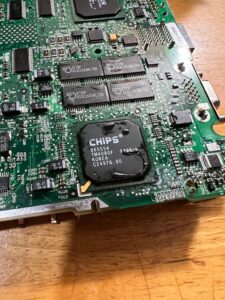 |
| Hello darkness my old friend… |
Last we left the Kanga, it was being a bit of a pain: It was suffering from an issue where it would display a distorted image–one that was interrupted by some black and white stripes every other pixel or so.
I did some more digging (and pushing the system) to try and see if this was an issue that could be fixed, or if it was one where I’d have to throw in the towel and phone in the likes of someone more experienced. As I played around more with the PowerBook, I found that the problem would go away temporarily if I applied pressure to a part of the bottom casing and refreshed the screen, either by dragging a window around to make the system redraw whatever was behind it, or by changing the color depth.
I later did more prodding by opening the PowerBook up and sticking the blunt end of a toothbrush down where the trackpad connector was. If I held slight pressure there? Problem would go away. Minute I pulled off of it? Artifacts reappeared. This quickly confirmed that this was a problem with a bad solder joint somewhere on the board, ostensibly on something to do with the video circuitry.
To make sure this wasn’t something dumb and more tragic–like the screen ribbon cable–I also hooked up an external monitor to the VGA port and yep, the artifacts appear on external too. So definitely not a ribbon cable. Whew.
With the help of the one and only dosdude1, I took a picture of the bottom of the board and he pointed me at where the video circuitry was: A CHIPS GPU and the associated VRAM, all right next to eachother. Neat.
Now, being absolutely overly paranoid that I was going to destroy this poor thing, I set my hot air station way too low: 200C. I did a 5 minute run with that, put it back together enough to test, and it seemed to work, even through some extended testing. I proclaimed victory, went to bed, and that was that.
Turns out solder will start to melt around those temps…if it’s the leaded solder that most of us use, with the proper mix to allow it to melt at that low of a temperature. What I probably needed was to boost the temperature by a sizeable amount–probably closer to 280-300C.
Nonetheless, that wasn’t going to stop me from going to bed happy. The next morning however…problem was back in full force, and I asked around before committing to yet another teardown. Thankfully once you get used to tearing down these PowerBooks they come apart fairly simply, so there’s that.
Knowledge in mind, I once again pulled the board from the Kanga, took it out to the garage and blasted it with 290C from my hot air station. Realized midway through that I used too much flux and that was a fun thing to have to clean up. Once that was done, however, I brought it back onto my desk, put it together enough to test, plugged it in and
SCREEEEEEEEEEEEEEEEEEEEEEEEEEEEE-
uh oh
Did I just kill this thing? Oh crap. Oh crap.
Gave it another once over with some 90% IPA and let it dry. Same thing happened. And it kept happening. I was now in full shitting bricks mode.
Before taking any drastic action, though, I opted to crudely connect the internal display to the logic board, hit the power, and
BONG